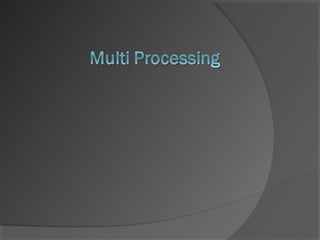
Multi processing
- 2. Multiple Processor Organization Single instruction, single data stream - SISD Single instruction, multiple data stream - SIMD Multiple instruction, single data stream - MISD Multiple instruction, multiple data stream- MIMD
- 3. Single Instruction, Single Data Stream - SISD Single processor Single instruction stream Data stored in single memory Uni-processor
- 4. Single Instruction, Multiple Data Stream - SIMD Single machine instruction Controls simultaneous execution Number of processing elements Lockstep basis Each processing element has associated data memory Each instruction executed on different set of data by different processors Vector and array processors
- 5. Multiple Instruction, Single Data Stream - MISD Sequence of data Transmitted to set of processors Each processor executes different instruction sequence Never been implemented
- 6. Multiple Instruction, Multiple Data Stream- MIMD Set of processors Simultaneously execute different instruction sequences Different sets of data SMPs, clusters and NUMA systems
- 7. Taxonomy of Parallel Processor Architectures
- 8. Parallel Organizations - SISD
- 9. Parallel Organizations - SIMD
- 10. Parallel Organizations - MIMD Shared Memory
- 11. Parallel Organizations - MIMD Distributed Memory
- 12. Symmetric Multiprocessors A stand alone computer with the following characteristics Two or more similar processors of comparable capacity Processors share same memory and I/O Processors are connected by a bus or other internal connection Memory access time is approximately the same for each processor
- 13. Continue…… All processors share access to I/O ○ Either through same channels or different channels giving paths to same devices All processors can perform the same functions (hence symmetric) System controlled by integrated operating system ○ providing interaction between processors ○ Interaction at job, task, file and data element levels
- 14. Block Diagram of Tightly Coupled Multiprocessor
- 15. SMP Advantages Performance If some work can be done in parallel, then system with multiple processors yield greater performance than single processor of the same type. Availability Since all processors can perform the same functions, failure of a single processor does not halt the system
- 16. SMP Advantages Incremental growth User can enhance performance by adding additional processors Scaling Vendors can offer range of products with different price and performance which are based on number of processors configured in the system
- 18. Organization Classification Time shared or common bus Multiport memory Central control unit
- 19. Time Shared Bus Simplest form Structure and interface similar to single processor system Following features provided Addressing - distinguish modules on bus Arbitration - any module can be temporary master Time sharing - if one module has the bus, others must wait and may have to suspend Now have multiple processors as well as multiple I/O modules
- 21. Time Share Bus - Advantages Simplicity Flexibility Reliability
- 22. Time Share Bus - Disadvantage Performance limited by bus cycle time Each processor should have local cache Reduce number of bus accesses Leads to problems with cache coherence Solved in hardware - see later
